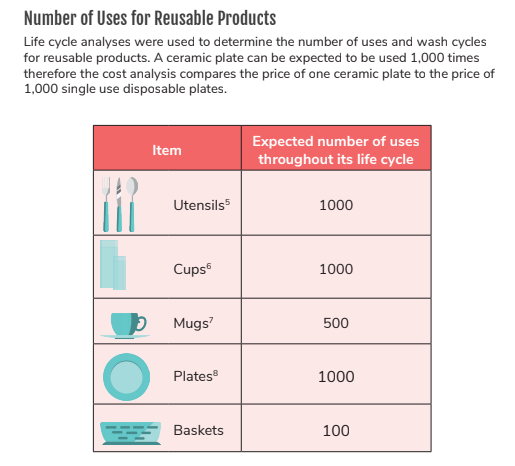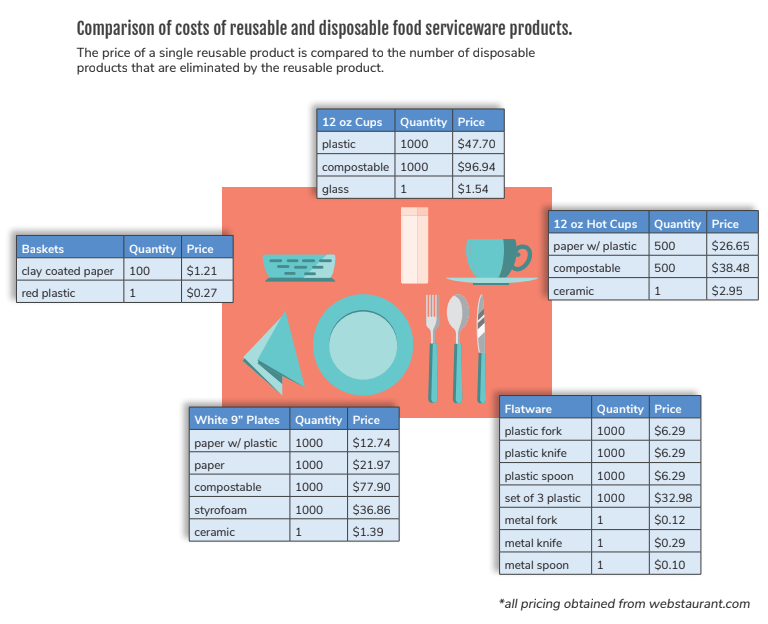How Reusables Can Help Restaurants Save
Since being fully vaccinated, nothing is more exciting than going out to restaurants again. Even ordering out and eating with friends feels like the greatest luxury.
So, what’s the catch? The drawback to this rediscovered joy is all the trash we get with our orders. We all know the feeling of opening that brown paper bag, excited that we didn’t have to cook, only to find a vast number of disposable utensils, straws, napkins, and condiment packets.
All of this goes to one of two places: the junk drawer or the trash. Even at a nice restaurant, it is common to be served single-use chopsticks, wrapped in paper and sealed inside a plastic wrapper.
It raises the question: is this waste really necessary or is there a better way?
How much does single-use cost?
Are disposables in food service operations helping restaurants or hurting them?
This is a hard time for restaurants, and cutting operational costs is always on the table to save money and grow their bottom line. We all want to support our local businesses, but we questioned whether all of these disposables were actually helping restaurants or hurting them. So we looked into the true cost of single-use foodware and the potential savings from ditching disposables and switching to reusables.
Here’s what we found.
Durability = Longevity
One of the best things about reusable products is durability. Lifecycle analyses show that reusable foodware, especially those made of ceramic, glass, and metal, provide a durable and lasting product.
Glass cups, ceramic plates, and metal silverware can all be expected to go through 1,000 uses and wash cycles.So, if a business replaces 1,000 plastic forks with a single metal one, how much can it save?
A Cost Breakdown: Disposables vs. Reusables
On a popular supply website for restaurants:
A set of 1,000 disposable forks costs $6.29. Comparatively, the cost of a single metal fork, which can be used 1,000 times, is just $0.12.
Restaurants pay $21.97 for 1,000 paper plates and $36.96 for styrofoam, when a ceramic plate is $1.39.
The cost of 1,000 single-use plastic cups is $47.50 and 1,000 compostable cups adds up to $96.94. The price of a glass cup? $1.54.
When serving any volume of customers, these savings are considerable. According to ReThink Disposable, a technical assistance service that works with restaurants to bring reuse into their operations, restaurants usually see a return of profit for the initial investment in just a few months, and always within a year.
And for the most part, restaurants can make the change without increasing washing capacity, like machine dishwashers or staff. For those that do, the cost is offset by the considerable savings from reduced spending on disposable replacements.
The cost savings in just a single meal are evident. Let’s consider when a consumer pops into a cafe for a snack.
For a shop serving single-use products, the price of one customer's meal, served with a hot cup and a paper plate, is $0.06. Every customer who walks out with a coffee and a scone costs the cafe that amount.
Meanwhile, a cafe serving reusable foodware pays less than $0.01 for their customer’s mug and plate.
Further still, the cost of a full dinner meal in a restaurant (fork, knife, spoon, plate, glass, mug, and a fries basket) adds up to $0.15 with single-use ware and just $0.01 with reusables!
How much can restaurants save with reusables?
What does all this add up to? A lot.
Small food service businesses can save $3,000 to $22,000 annually by serving their food on reusable products, even after factoring in costs for dishwashing and purchasing reusables.
The industry as a whole, which spends over $20 billion annually on single-use products, can save $10 billion just by replacing 20% of plastic food packaging with reusable alternatives. That’s 50% in savings! Those numbers are favorable in any industry.
Businesses that Successfully Made the Switch
None of these savings are hypothetical. Great businesses of all sizes have made the switch to reusables. Let’s look at some examples.
Hang Ten Boiler
With the help of Rethink Disposable, the Hang Ten Boiler in Alameda, CA, began service on reusable food ware for their 50 seats of indoor dining.
Initial, one-time investment: $2,000
Annual staffing cost for one part-time dishwasher and other upkeep: $12,000
Net annual savings: $4,000
Crispin Bakery
The Crispin Bakery, also of Alameda, took a different route and chose to rent a dishwasher.
Monthly dishwasher rental cost: $75
Initial, one-time dishwasher installation cost: $500
Monthly water bill increase: $30
Net annual savings: $1,700
University of San Francisco Market Cafe
Looking at a larger scale, the University of San Francisco's Market Cafe, which services its 5,000 students daily, also switched to reusables. Before the changes, the university spent $340,000 annually on disposable foodware. After the changes, the dining hall did not have to increase dishwashing capacity or labor.
Initial investment to buy reusable products: $5,000
Cost of upkeep (replacing dishes and necessary washing supplies): $27,000
Net annual savings: $150,000
Why should restaurants go reusable?
Disposable foodware costs are borne solely by the restaurant. With so many restaurants struggling right now, why should they pay more for foodware than they have to?
Beyond Money: The Benefits of Reusables
Financial savings are not the only benefit of reusable foodware products. Here are some other reasons restaurants should switch from disposables to reusables.
Higher quality makes happier customers
Customers really like reusables. They are higher quality products than their single-use alternatives, which leads to a better dining experience.
Opportunities for brand growth
The ability for restaurants to personalize the style of reusables increases brand loyalty. Many customers also value the considerable environmental benefits.
Less waste helps the environment
Reusable foodware produces 85% less carbon than single-use over its lifetime. They also reduce lifecycle water use and a huge amount of disposable waste. Switching to reusables is a choice businesses and consumers can feel good about.
“The industry as a whole, which spends over $20 billion annually on single-use products, can save $10 billion just by replacing 20% of plastic food packaging with reusable alternatives.”



